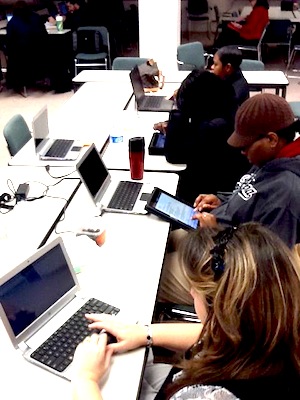When it comes to educational technologies, fashion often overrides sound practice. With national writing scores stagnant for more than three decades, the chance for improvement thanks to computers has been squandered. This loss is mainly due to a lack of understanding about mind mapping and writing as process.
With the advent of the iPad, some schools rush to fill classrooms with such devices without noting the limitations of such equipment when it comes to idea processing and revision. Many of the decision-makers are not writers, do not use mind mapping in their own work and have not used iPads for enough hours to know about their limitations. They may be unwittingly undermining the future writing performance of their students.
 Last year I had the good fortune to work with a district in the Chicago suburbs that set up a side by side comparison of laptops and iPads during six days of intense professional development. During these days it became evident that iPads can do many things well but stumble when it comes to the kinds of idea processing and revision we would hope to see in order to meet the writing goals of the Core Standards. Most participants favored the laptops when it came to what we might call heavy lifting. Last year I had the good fortune to work with a district in the Chicago suburbs that set up a side by side comparison of laptops and iPads during six days of intense professional development. During these days it became evident that iPads can do many things well but stumble when it comes to the kinds of idea processing and revision we would hope to see in order to meet the writing goals of the Core Standards. Most participants favored the laptops when it came to what we might call heavy lifting.
Heavy lifting? It is the kinds of thinking, writing and production required by the Core Standards. For more on this concept take a look at "Is the iPad a Game Changer?"
The Development of Powerful and Persuasive Ideas
Having started many articles and books with laptop mind maps created on Inspiration™, I wondered what would happen on an iPad. I found no apps that came close to the power of mind mapping possible on a laptop. Even now, as Inspiration offers an app for the Ipad, it strikes me as a much less powerful tool for students, writers and thinkers than the laptop version.
The diagram below was generated on a laptop and would have been difficult to produce on an iPad.

Really good mind-mapping involves major weaving and revision of early ideas. This works easily on a laptop as described in "Connecting the Dots."

 With many states moving toward assessment of student writing on computers to demonstrate success with the Core Standards, it is folly to plunge forward with learning and teaching strategies that treat these tools like glorified typewriters. Student success depends upon idea generation and the development of logical arguments expressed in stylistically persuasive rather than turgid or formulaic prose. With many states moving toward assessment of student writing on computers to demonstrate success with the Core Standards, it is folly to plunge forward with learning and teaching strategies that treat these tools like glorified typewriters. Student success depends upon idea generation and the development of logical arguments expressed in stylistically persuasive rather than turgid or formulaic prose.
The development of ideas is one thing. Composing one's thoughts on mind mapping software can enhance the process only if the students are well versed in synthesis and constructivist principles. If not, it may be a silly diversion.
Few teachers have been equipped with the synthesis skills and strategies they should be explaining and demonstrating to their students. Examples of these strategies can be found at Bettering - A Synthesis primer. Possession of laptops or iPads will do little for student writing success unless both teachers and students are fully equipped with a robust array of such skills. These skills will strengthen the quality of thinking at the outset and then enhance the revision process.
Revision of Early Drafts
Once the idea is well considered, the students must compose sentences and paragraphs to articulate or make the case for their beliefs. This process should be recursive (like a cat chasing its tail) as the writer employs revision strategies offered by models like the Six Traits of Effective Writing. The students revise, revise and then revise some more.
- Ideas and Content
- Organization
- Voice
- Word Choice
- Sentence Fluency
- Conventions
For each of these aspects of powerful writing, the student has learned to ask a dozen questions like the following:
Ideas and Content
How can I . . .
- Change the way I write my sentences so that the main ideas stand out more clearly?
- Add evidence or examples so that my ideas stand with enough support?
- Add details, testimony or information which will make my paper more convincing?
- Explain my reasons for not agreeing with opposing ideas and possibilities?
Improve the logic of my argument?
- Strengthen the connections between ideas, examples and illustrations?
For more examples of such questions go to http://fno.org/sept98/infolit5.html
If a school or a district does not focus professional development and teaching on mind-mapping and the powerful revision of early drafts, they are not making full and appropriate use of new technologies as envisioned by the CCS and their students are unlikely to shine on the new writing assessments soon to arrive from groups like The Smarter Balanced Assessment Consortium. The material below is quoted directly from their Web site:
Preliminary Test Blueprints
The Smarter Balanced preliminary test blueprints describe the content of the English language arts/literacy and mathematics summative assessments for grades 3–8 and high school—and how that content will be assessed. Developed with broad input from member states, partners, and stakeholders, the preliminary test blueprints reflect the depth and breadth of the performance expectations of the Common Core State Standards. Smarter Balanced Governing States adopted the preliminary summative test blueprints in November 2012.
|



 Last year I had the good fortune to work with a district in the Chicago suburbs that set up a side by side comparison of laptops and iPads during six days of intense professional development. During these days it became evident that iPads can do many things well but stumble when it comes to the kinds of idea processing and revision we would hope to see in order to meet the writing goals of the Core Standards. Most participants favored the laptops when it came to what we might call heavy lifting.
Last year I had the good fortune to work with a district in the Chicago suburbs that set up a side by side comparison of laptops and iPads during six days of intense professional development. During these days it became evident that iPads can do many things well but stumble when it comes to the kinds of idea processing and revision we would hope to see in order to meet the writing goals of the Core Standards. Most participants favored the laptops when it came to what we might call heavy lifting.

 With many states moving toward assessment of student writing on computers to demonstrate success with the Core Standards, it is folly to plunge forward with learning and teaching strategies that treat these tools like glorified typewriters. Student success depends upon idea generation and the development of logical arguments expressed in stylistically persuasive rather than turgid or formulaic prose.
With many states moving toward assessment of student writing on computers to demonstrate success with the Core Standards, it is folly to plunge forward with learning and teaching strategies that treat these tools like glorified typewriters. Student success depends upon idea generation and the development of logical arguments expressed in stylistically persuasive rather than turgid or formulaic prose.